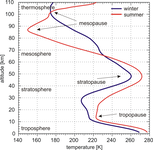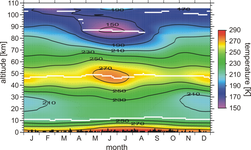Temperatures at 54°N
Knowing the temperature structure in height and time establishes the basis to understand the climate of the earth. We perform temperature soundings by lidar since 2002 at Kühlungsborn. During the first years, these soundings have been limited to nighttime. Since 2010, regular soundings are also performed during daylight.
Mean temperature profiles of the winter (November – January) and the summer (June, July) measurements are calculated and shown in the Figure below. The well-known temperature differences in the troposphere, i.e. high temperatures are found in summer and low temperatures are found in winter, proceed into the stratosphere. Above the stratopause the temperature gradient is much larger in summer (about - 4 K/km) as in winter (about -1 K/km). Accordingly, the summer mesopause is found at low altitudes (about 87 km) and its temperature is very low (<150 K). In contrast the winter mesopause is found at higher altitude (about 104 km) and is also about 15 K warmer than in summer. This phenomenon is called two-level-mesopause and is much more pronounced at polar latitudes .
A represantative seasonal variation of temperatures is obtained from applying a harmonic fit to the data. The height structure of the atmosphere showing the different layers is similarly represented in the winter/summer profiles and in the seasonal plot. The largest temperature changes are observed around the stratopause (40-50 km) and around the mesopause (85-105 km). In the middle mesosphere (65-75 km) temperatures are nearly constant throughout the year.
Selected publications
M. Gerding, M. Kopp, J. Höffner, K. Baumgarten und F.-J. Lübken, Mesospheric temperature soundings with the new, daylight-capable IAP RMR lidar, Atmos. Meas. Tech., 9(8), 3707-3715, doi:10.5194/amt-9-3707-2016, 2016.














